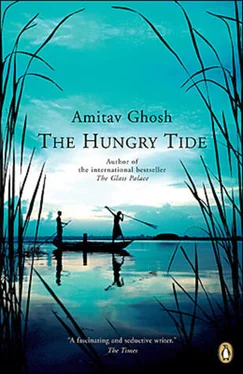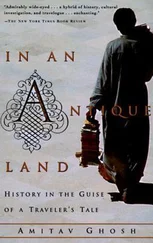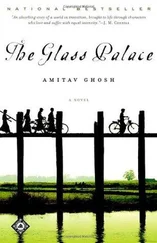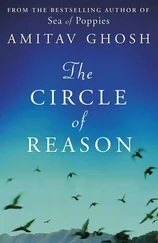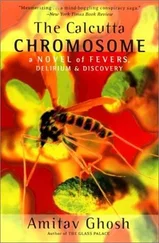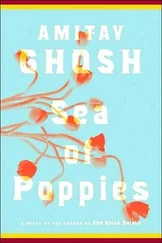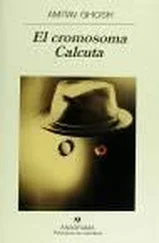“Moyna, this is Kanai-babu,” said Nilima. “He’s my nephew.”
“ Nomoshkar, ” she said, stepping in.
“ Nomoshkar. ” The light had caught her face now, and seeing her close up, Kanai saw that the kajol had spilled over the rims of her eyes. Her complexion was dark and silky and her raven-black hair shone with oil. Her face was marked by a sharply outlined brow and a prominent jaw; he could tell at a glance that she was not one to be shy of pitting her will against the world. Yet from the redness of her eyes it was clear she had been crying.
“Listen, Kanai,” said Mashima, switching to English so as not to be understood by Moyna. “Be careful with this girl — she’s clearly very upset.”
“Of course,” said Kanai.
“Righty-o, then,” said Nilima. “I suppose you had better be going.”
Righty-o? It was not often that Kanai heard his aunt speak English, and he was struck by her distinctive and unexpected diction. Her Bengali, after years of living in the tide country, had almost converged with the local dialect, having been stripped of the inflections of her urban upbringing. But her English, possibly because she spoke it so rarely, had survived like a fern suspended in amber, untouched by time and unspoiled by the rigors of regular usage, a perfect specimen of a tongue learned in the schools of the Raj. It was like listening to a lost language, the dialect of a vanished colonial upper middle class, spoken with the crisp enunciation once taught in elocution classes and debating societies.
AS THEY WERE starting down the path to the hospital, Kanai said to Moyna, “Did Mashima tell you I knew your mother-in-law?”
“No!” cried Moyna, throwing him a look of surprise. “Mashima didn’t mention it. Did you really know her?”
“Yes,” said Kanai. “I did. It was a long time ago, of course. She must have been about fifteen. And I was younger.”
“What was she like?”
“What I remember is her tej, ” Kanai said. “Even at that age she was very spirited.”
Moyna nodded. “I’ve heard people say she was like a storm, a jhor. ”
“Yes,” said Kanai. “That’s a good way of putting it. Of course, you never knew her yourself, did you?”
“No,” said Moyna. “I was just a baby when she died. But I’ve heard many stories about her.”
“Does your husband talk about her?”
Moyna’s face had brightened in speaking of Kusum, but now, at the mention of Fokir, it fell again. “No,” she said. “He never speaks of her. I don’t think he remembers much of her either. After all, he was very little when she died —” She shrugged, cutting herself short, and Kanai thought it better to let the subject drop.
They were nearing the hospital now, and seeing the building close up gave Kanai a renewed appreciation of the sheer scale of Nilima’s achievement. It was not that the building was overly large or particularly striking in its design; a mere two stories high, it was built in the shape of a squat shoebox. Its outer walls were painted gray, while the windows and the railings of its long corridors were outlined in white. There was a garden in front, planted largely with marigolds. Yet, plain as it was, in this tide country setting where mud and mildew encrusted everything, the building’s crisp lines and fresh paint were enough to give it the exclamatory salience of a skyscraper. Kanai could tell that the mere sight of it gave heart to the people it served.
This was clearly the effect it had on Moyna, for there was a noticeable improvement in her demeanor as she led Kanai to the hospital. With every step her carriage seemed to become a little straighter and her movements more assured: it was as though the mere proximity of the building had caused a brisk professional to emerge from the chrysalis of a careworn wife and mother.
Leading Kanai through the hospital’s entrance, Moyna ushered him to a door. Then, speaking in a voice hushed with pride, she announced, “And this is the Maternity Ward.”
Hospitals were not, as a rule, of much interest to Kanai, but this was an exception: he could not help being impressed by the impeccable maintenance of the wards. Every part of the hospital seemed to be spotlessly clean and even though it had only forty beds, it was, for its size, well equipped. The equipment had come from donors, Moyna explained, some Indian and others foreign. There was a diagnostic laboratory, an x-ray room and even a dialysis machine. On the top floor lived two resident doctors, one of whom had been in Lusibari for ten years. The other was a new arrival who had just completed his residency requirements at the prestigious medical college of Vellore. They were both, Moyna said, prominent and muchbeloved figures on the islands. Every patient who came to the hospital made it a point to leave an offering at their door — a coconut, a few kewra fruit, a fish wrapped in leaves, sometimes a live chicken or two.
Such was the hospital’s reputation, Moyna said, that people now came there from great distances. Many who could have traveled more conveniently to Canning or Kolkata chose to come to Lusibari instead: the hospital was known to provide, at a nominal fee, a standard of care that could not be had elsewhere even at exorbitant rates. This traffic, in turn, had led to the growth of a small service industry around the hospital’s perimeter. Over the years, a number of teashops, guest houses and stands for cycle-vans had taken root and flourished. Directly or indirectly the hospital now provided employment for the majority of Lusibari’s inhabitants.
On the upper floor Moyna pointed out Nirmal’s single contribution to the hospital: a large ward specially equipped to withstand cyclones. The windows had thick wooden shutters and the doors were reinforced with steel. Although he had rarely interfered in anything to do with the Trust, when the hospital was under construction Nirmal had taken the trouble to find out if any anti-cyclone measures had been provided for. He was horrified to learn that they hadn’t: did nobody know about the tide country’s history of catastrophic cyclones? Did they think that Lusibari was the one place where history would not repeat itself? It was at his insistence that this ward was built.
From a veranda on the second floor, Moyna pointed to the stalls and clusters of huts that ringed the compound. “Look over there, Kanai-babu,” she said. “Look at the shops and stalls that have come up around the hospital. See how many there are?”
Kanai was touched, moved even, by Moyna’s evident pride in the institution. “Have you ever brought Fokir here?” he said.
She answered this with a small shake of her head. “No.”
“Why not?”
She pulled a face. “He doesn’t like to come — he feels out of place.”
“In the hospital, you mean? Or in Lusibari?”
“Both,” she said. “He doesn’t like it here.”
“And why is that?”
“Things are different here than they were in the village.”
“In what way?” Kanai asked.
She shrugged. “Over there he was always with Tutul — our son,” she said. “Because of my work with the Trust I was out of the house a lot, so Tutul was with him on the river all day. But after we came here I had to put a stop to that.”
“Really? Why?”
“Because Tutul has to go to school, doesn’t he?” she said sharply. “I don’t want him growing up catching crabs. Where’s the future in that?”
“But that’s what Fokir does.”
“Yes, but for how long?” she said. “Mashima says that in fifteen years the fish will all be gone, what with the new nets and all.”
“What new nets?”
“These new nylon nets, which they use to catch chingrir meen — the spawn of tiger prawns. The nets are so fine that they catch the eggs of all the other fish as well. Mashima wanted to get the nets banned, but it was impossible.”
Читать дальше
Конец ознакомительного отрывка
Купить книгу
